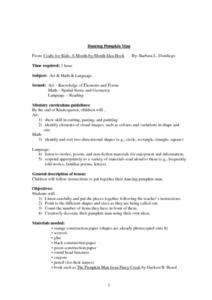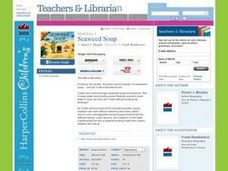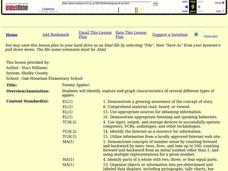Curated OER
Math: Musical Patterns
Students employ their five senses to interpret and duplicate instrumental patterns. Following the teacher's patterns, students clap their hands and later use instruments such as bells, triangles, or cymbals to create their own "songs."
Curated OER
Our Daily Five
Students explore the food pyramid through a class discussion, hands-on experience with food items, and a floor game that helps them to identify the food group involved. Lesson extensions include the use of play money, art, and dance.
Illustrative Mathematics
Making a Clock
Have a fun time teaching children to read analog clocks with this whole-group math activity. Using large sets of the numerals 1-12 and 0, 5, 10...55, the teacher creates a large clock on either the carpet or the white board, explaining...
Curated OER
Agriculture Counts
Students practice counting. In this early numbers lesson, students learn about the beginnings of agriculture and how it ties into math. Students practice counting objects related to agriculture.
SeaWorld
Sharks
Youngsters explore their sense of smell by working in pairs. One child is blindfolded, while the other holds things for him to smell. They switch after a while. All of this leads up to learning about the amazing ability sharks have to...
Virginia Department of Education
Weather Patterns and Seasonal Changes
Get your class outside to observe their surroundings with a lesson highlighting weather patterns and seasonal changes. First, learners take a weather walk to survey how the weather affects animals, people, plants, and trees during...
Curated OER
Get in Shape with Geometry
Using geoboards, computer programs, and hands-on manipulative materials, elementary schoolers engage in a study of two and three-dimensional geometric shapes. This lesson is chock full of good teaching ideas on the subject, and the...
Curated OER
Recognizing Litter
When does trash become litter? Use this litter awareness lesson to help them understand the importance of trash disposal. Get learners engaged by reading Nancy Loewen's Lady Lulu Liked to Litter (not included). After discussing what...
Curated OER
Through the Eyes of the Big Bad Wolf
Imagine how the wolf would tell the tale of Little Red Riding Hood or The Three Little Pigs. Young writers re-imagine classic tales by adopting the point of view of another character in the story. After reading models like The True Story...
Curated OER
Activity Plan 5-6: Bugs, Bugs, Bugs!
Learners become entomologists for a day. In this life science lesson plan, students go on an insect hunt and investigate insects and their homes. This leads to the creation of an insect by each student. Lesson includes a take-home...
Curated OER
Now That's News To Me!
Learners observe how newspapers help to build a sense of community. They identify the important events and people within their school community and create a newspaper page/section. They choose photographs or clippings to use on their...
Curated OER
Looks Like Respect, Sounds Like Respect, Feels Like
Students explore philanthropy through art. In this service learning lesson, students discuss the diversity in their community and use their senses to create tolerance posters.
Curated OER
Smells Like Christmas, Exploring the Nose
Students discover that the sense of smell helps us to enjoy life and explore unsafe conditions. They smell Christmas by making gingerbread ornaments.
Curated OER
Poppin Popcorn
Students use their senses to write descriptive sentences. In this descriptive writing lesson, students discuss their senses. Students are asked to look at and feel unpopped corn kernels. Students then write descriptions of the corn...
Georgia Learning Connections
Stand By Me!
Get your little mathematicians moving with this experiential activity in which one child is the "tens" and another is the "ones." They collect the number of unifix cubes (in tens or singles) assigned to their respective place values and...
Curated OER
Dancing Pumpkin Man
Students listen carefully and put pieces together following the teacher's instructions. They point to the different shapes and sizes as they are being called out and count the number of items they have in front of them. They decorate...
Curated OER
ESOL Lesson, Beginning
Young scholars identify the names of body parts on flashcards. The students participate in a "L" game, and illustrate a puppet and name the body parts. Young scholars also identify the names for popular fruit. Students use all senses to...
Curated OER
Tasters' Choice
Students taste foods, some of which are familiar foods and some of which are uncommon foods. They compare and contrast the tastes and graph their likes and dislikes.
Curated OER
Homes for Hermit Crabs
Learners discover the differences between hermit crabs and mollusks and identify their parts. After reading a story about hermit crabs, they complete an anatomy worksheet. For another activity, students fold and cut a diagram of a hermit...
Curated OER
Living and Nonliving
Students use their senses to record and collect data. In How Do I Classify Things in My World?, students practice classifying objects as living or nonliving. In Is it Real Or Pretend?, students group objects as real or pretend. In What...
Curated OER
Seaweed Soup
Students read the book Seaweed Soup and learn about matching. For this matching lesson plan, students read the given book, and have to keep track of all the different bowls, cups, spoons, and napkins on the table by matching them up.
Curated OER
What Can I Do?
Students identify how they are feeling and deal with feelings constructively. In this conflict resolution lesson plan, students explore their feelings through discussion. Students read and complete the What Can I Do? e-sheet. Students...
Curated OER
50 State Quarter Game
Students, using their knowledge of place value and number sense, play this counting game in small groups, or as a whole class, to see who be the first person to reach 50 cents.
Curated OER
Yummy Apples!
Students discuss apples and how they are grown. They listen as the teacher reads "Apples," by Gail Gibbons. Students discuss the story. They view several different types of apples and compare their characteristics. Students taste several...























